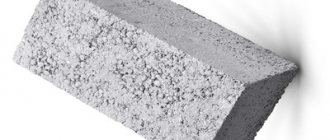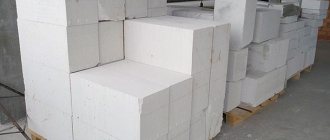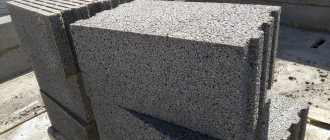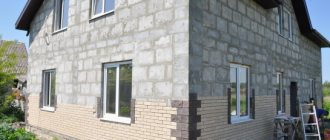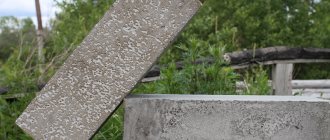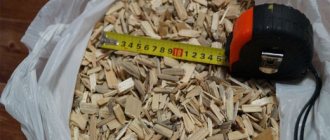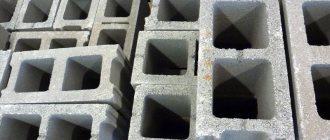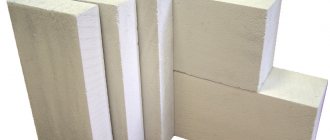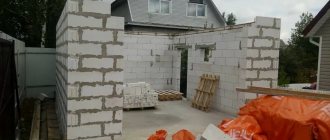The development of construction technologies leads to improved construction quality. Time-tested materials are combined in new ways, creating unexpected combinations with impressive properties. This is what happened with concrete. The material, widely used by the builders of Ancient Rome, after a series of experiments became the ancestor of lightweight concrete.
Foam concrete can be considered one of the most successful and widespread varieties of this group. Foam concrete blocks, the characteristics of which best meet the requirements of building regulations, allow you to make maximum use of the best properties of the material.
House wall made of foam blocks Source lt.decorexpro.com
What is foam concrete - everything you wanted to know
Foam concrete belongs to the group of cellular concrete. It is often confused with aerated concrete, which differs in composition and final processing technology (can be autoclaved or non-autoclaved).
The basis of foam concrete is sand, water and cement. Production technology has remained virtually unchanged since the 1930s. Foaming additives, organic or synthetic, are added to the cement mortar. Additives foam the mass of the solution, saturating it with air bubbles and increasing the volume. The bubbles are distributed throughout the mixture, and when cured, they leave closed cavities (cells). Such pores reduce the density of the material; In addition to lightness, concrete acquires other properties useful for construction.
Since a cementitious binder is used to produce cellular concrete, its strength continues to increase long after production (tests have shown that strength increases 3-4 times after 30-40 years of operation).
Foam concrete blocks according to GOST Source kamtehnopark.ru
Technology for the production of foam concrete blocks
The production of foam concrete does not require the construction of a complex technological chain. The cement-sand mixture is placed in a mixing container, into which additives are supplied from the foam generator in the form of foam in an aqueous solution. A complex of foaming agents increases the strength and frost resistance of the material, reduces thermal conductivity and drying shrinkage. There are two types of foam concentrates:
- Organic (protein origin). The product is environmentally friendly and more durable (the cell walls are thicker).
- Synthetic. The material has hazard class 4 (can release toxic substances) and is less durable; not recommended for residential construction.
Sometimes VSM fiber fiber (construction micro-reinforcing fiber) is used as an additive, which increases the strength of the material or dry ash (fly ash), which allows saving cement.
Mixing of the starting components occurs under pressure. Then the mixture is cast into special molds (cassettes) or as a monolith. In the second case, after drying, the mass is cut to specified sizes.
After production, foam concrete blocks are additionally aged in the warehouse Source kamtehnopark.ru
Excess water evaporates during drying. Hardening occurs naturally, which reduces the uniformity of the fine-cell structure (compared to aerated concrete). The simplicity of the process allows you to prepare foam concrete directly on the construction site. The material turns out to be cheap, since its production requires 2-4 times less cement.
How to evaluate the quality of a material by appearance?
- Linear geometry. Handicraft production often suffers from disproportion between the sides.
A simple way: place one block on top of another, and check for the presence/absence of: gaps, protrusions, evenness of the edge and for wobble; - Color. The entire batch should have a uniform gray color. A light shade may indicate a lack of cement in the composition of foam concrete (do not confuse it with aerated concrete, as it is almost white and has a slightly grayish tint);
- Weight. Ask them to weigh the block and compare it with what they previously name (employees of the selling company). The difference in weight indicates a discrepancy with the declared density;
- Uniformity of pore structure . Take the broken piece: the structure and size of the pores should be in approximately the same proportion on both the outer and inner parts of the foam block;
- Durability . Try to break off a piece from the edge or try (using the strength of your hands) to stick a nail into the block. If it succeeds, then the material is bad.*
*There is a caveat here, we are talking about the material for constructing walls, that is, with a density of D 600 and higher. But foam concrete of lower density is relatively fragile and can be broken by hand without much effort.
As you can see, if you take into account all the good aspects and prevent the bad ones as much as possible, you can build a good house or bathhouse. So, good luck with your construction.
An anecdote on the topic: The teacher asks Vovochka: “Why did you throw a brick at Uncle Vasya?!” - I won't do it again. - And he doesn’t need any more.
I wish you success in life and a warm, cozy home for your family! And don't forget to subscribe to blog news. Bye!
Wisdom Quote: Always check quotes: yours before you say them, others’ ones after they are said (Winston Churchill).
Technical characteristics of foam concrete
With the growing volume of low-rise construction, the popularity of foam concrete products is increasing. Foam blocks, the sizes and prices of which are very variable, also attract with their set of technical and operational properties.
Advantages and disadvantages of foam block
- Low density. Structures made of lightweight material exert the minimum possible pressure on the foundation (the density is 4 times less than that of expanded clay concrete).
- Strength. Allows the construction of load-bearing walls (in buildings up to 3 floors of grades from D900 and above).
- Thermal conductivity. 3-4 times lower than that of ordinary brick. Low thermal conductivity provides comfortable living conditions in any climate, keeping the room cool in summer and warm in winter. The consequence is energy saving.
- Soundproofing. An important factor in urban environments.
- Fire hazard. Foam concrete is a non-flammable material.
The unilateral exposure limit is 5-7 hours Source theconstructor.org
- Moisture resistance. Blocks made in accordance with GOST have almost no open pores and are able to float on the surface of water for days without absorbing it.
- Environmental friendliness. Foam block with organic foaming agents does not emit toxic substances.
The disadvantages include the unesthetic appearance of the building, which requires finishing. It is also necessary to monitor the geometry of the products. Due to the uneven surface, the width of the mortar joints increases. To prevent thermal conductivity from deteriorating, the parameter should not exceed 2 mm; Why is it more convenient to use glue?
See also: Catalog of projects of houses made of foam concrete blocks presented at the exhibition “Low-Rise Country”.
Unique advantages that the foam concrete block has
- Saving money. The material itself is cheap, which allows you to save on purchases. Plus, thanks to the lightness of foam blocks, the foundation for a house can be made less powerful, which also reduces the budget. Costs for transportation, storage and wall laying are reduced.
- Saving time and labor costs. Foam block, which is much larger in size and lighter in weight than brick, allows you to simplify and speed up the construction process.
A definite plus is ease of processing Source stavba.ru
- Ease of processing. Foam blocks are easy to cut, drill and groove with a standard tool, a grinder or a hand saw. This simplifies all types of work - finishing, plumbing and electrical wiring.
Disadvantages of foam concrete blocks that sellers are silent about
Foam concrete blocks are a proven raw material for private construction and insulation of walls of finished buildings. Like any material, foam concrete has a number of features, ignorance of which leads to improper use and disappointment.
Low compressive strength
In an effort to reduce production costs, a manufacturer can use raw materials (cement) of low quality. When purchasing a batch of blocks, it is worth checking the certificate. You can check the brand strength by driving a nail 10 cm long into the foam block. Strength corresponds to the standard if it cannot be removed with bare hands.
The manufacturer seeks to avoid additional costs for storing finished products. The brand strength of foam concrete (100%) is achieved only on the 28th day after production and subsequently increases over the course of decades. Using blocks before the expiration of this period (1 month) can lead to shrinkage and cracks in the finished structures.
Loading a batch of foam concrete Source coralz.ru
Minuses
Like other building materials, foam blocks are not without their drawbacks. More details about each of them:
Low strength .
Since the material is lightweight and porous, it is very easy to cut with a hacksaw. This indicates the relatively low strength of the stone. This disadvantage is clearly manifested when transporting the material to the construction site. In case of careless transportation, up to 20% of the material becomes defective.- Low load-bearing capacity . You can drive a nail into the foam blocks, but it will be difficult to fix the cupboard on such a wall without additional fasteners.
- shrinkage . Over time, the house is made of 2-3 mm of foam concrete per linear meter. A minimum of 6 months must pass before finishing can begin.
- The need for reinforcement . To make the building last longer, it is recommended to additionally reinforce every 4 rows of masonry with metal rods. Builders also advise doing reinforcement on all door and window openings, which will entail additional financial expenses.
When foam concrete masonry shrinks, a large crack may appear along the wall - this is also one of the most significant disadvantages of this material.
Types and characteristics of foam blocks (sizes and weight)
Foam concrete blocks, the sizes and prices of which fit into several classes, are divided depending on their density (the number of air cavities per unit volume) and purpose. The fewer pores, the higher the density, thermal conductivity, strength and dimension of the brand.
- Construction blocks. Grades D1000-D1200 are used for load-bearing structures. Such blocks take on the weight of the floors, the next floor and the roof. They have maximum strength and weight.
- Combined blocks (structural and thermal insulation). Grades D600-D900 are suitable for load-bearing structures and effective thermal insulation in private construction.
External differences between brands with different densities Source 1beton.info
Company manufacturer
Take the time to go to the office, see how specialized it is, look at the certificates.
Try to look at the storage location of the foam blocks. In a company that respects the client, it should be under a roof, and not on bare ground.
Proper storage Incorrect storage
Also, ask how many years this company has been on the market and pay attention to communicating with their clients. They can provide useful information for your subsequent decision.
Prices for foam blocks
The price of a foam block depends on the manufacturer and brand. Average prices:
- A structural block of standard size 600x300x200 will cost 3200-4500 rubles. /1 m³.
- Structural and thermal insulation block (wall) – 120-140 rubles/piece; half block – 60-75 rub. /PC.; the average price of 1 m³ varies between 3200-3800 rubles.
- A thermal insulation block of brands D100-D500 and dimensions 400x200x600 mm will cost 2700-3000 rubles. /1 m³, 1 block costs 117-120 rubles.
Ideal geometry of quality products Source derevyannyy.com
The dimensions of foam concrete blocks may vary between different manufacturers. When purchasing, you should pay attention to the color and surface quality of the material. High-quality foam concrete should have a uniform grayish color. According to the technology, the blocks cannot turn out bright white; disruption of the process leads to brittleness. There should be no chips or cracks on the smooth surface, the cells should not be connected to each other.
Video description
A visual comparison of foam blocks and gas blocks in the video:
- Gas block is 3-4 times stronger than foam block (if we compare brands with equal density); the plaster lays on it more evenly. At the same time, aerated concrete easily absorbs and releases moisture. With the same density, the foam block floats on the surface of the water, while the aerated concrete block is partially submerged in the water.
- The porosity of aerated concrete is more uniform than that of foam concrete, this is due to the peculiarities of production. Due to pores of different sizes, the thermal conductivity of different foam concrete blocks may differ.
- A wall made of foam blocks absorbs moisture more slowly than a wall made of gas blocks. But both facades need protection from direct contact with water.
- Aerated concrete is made from natural ingredients. In the production of foam blocks, foaming agents of synthetic origin are used, which can be harmful to human health.
Application of assembly adhesive Source besplatka.ua
- Foam concrete blocks are more profitable (cheaper) than aerated concrete ones. But more money will be spent on cement mortar for masonry than on glue.
Foundation
The construction of foam blocks is lightweight, so the basis of the structure may well be a strip foundation (shallow, recessed). Foam blocks play the role of permanent formwork.
The properties of the material allow it to be used for insulation. This makes it possible to save on insulation and additional installation. The basement or ground floor will be dry and warm.
The absence of condensation will eliminate microbiological processes on indoor surfaces. However, you can use blocks in the foundation on non-heaving soil. The grade of material should be of the highest density.

